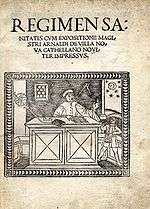Regimen sanitatis Salernitanum

Regimen sanitatis Salernitanum, Latin: The Salernitan Rule of Health (commonly known as Flos medicinae or Lilium medicinae - The Flower of Medicine, The Lily of Medicine) is a medieval didactic poem in hexameter verse. It is allegedly a work of the Schola Medica Salernitana (from which its other name Flos medicinae scholae salerni is derived).
Origin
The Regimen is believed to have been written in the 12th or 13th century, although some sources estimate this to have been as early as 1050.[1] Even though the book bears the name of the famous medieval medical school, it is not certain if it originated there. According to tradition, the poem was written for the benefit of Robert Curthose. The true author is unknown, but it is commonly attributed to John of Milan.
Content
This poem concerns domestic medical practice such as daily hygienic procedures and diet (e.g. it illustrates the therapeutic uses of wine).[2] The early Regimen was organized by the six non-naturals. According to Galen, they are: air, food and drink, sleeping and waking, motion and rest, excretions and retentions, and dreams and the passions of the soul. The original content addressed the Humors, the Complexions (Temperaments), and some diseases. It also contained a phlebotomy, which provided information on bloodletting.[3]
The original Latin version was annotated and edited by Arnold of Villanova. The Regimen was contemporary with Secretum Secretorum, a health manual written by pseudo-Aristotle. However, the Regimen was more popular because the rhyming verses were easier to remember. The Regimen was translated into vernacular languages, including Irish, Bohemian, Occitan, Hebrew, German, Anglo-Norman, and Italian.[3] Following its first appearance in print, the Regimen was translated into almost every European language, and the book achieved tremendous popularity and nearly forty different editions were produced before 1501. The work itself came to be highly revered as a scholarly medical text and was seriously discussed until the 19th century. Various editions and versions of the Regimen circulated throughout Europe, many with commentaries that added or removed material from the original poem. During this interval, the Regimen was expanded from the original 364 lines to 3,526 hexameter verses.[3] The first English translation was made by Sir John Harington in 1608. An attempt to make a medically accurate translation was made in 1871 by the American doctor John Ordronaux.[4]
Quotes
- Why should a man die who has sage in his garden? (Latin: Cur moriatur homo, cui salvia crescit in horto?). Cf. Contra vim mortis non crescit herba in hortis.
- Si tibi deficiant medici, medici tibi fiant
- Haec tria: mens laeta, requies, moderata diaeta (Latin text).
- Use three physicions still; first Doctor Quiet,
- Next Doctor Merry-man and Doctor Dyet (Harington's translation, 1608).
- If doctors fail you, let these three be doctors for you:
- A joyful mind, rest, and a moderate diet. (Modern translation)
References and footnotes
- ↑ (German) bibliotheca Augustana
- ↑ "Chronology of Wine as a Medicine". Archived from the original on August 25, 2003.
- 1 2 3 Melitta Weiss Adamson: Food in Medieval Times, pp. 217-220. Westport, CT: Greenwood Press, 2004. ISBN 0-313-32147-7
- ↑ Ordronaux, J. Translation into English verse of Regimen Sanitatis Salerni. Scuola Medica Salernitana. Lippincott, 1871.
See also
- Domhnall Albanach Ó Troighthigh
- Breviarium de signis, causis et curis morborum
External links
- English text
- Latin text
- Editions reviews
- Code of Health of the School of Salernum: Translated Into English Verse by John Ordronaux. Internet Archive online document